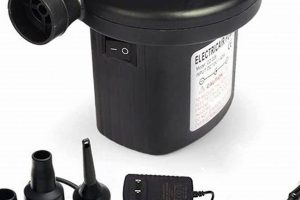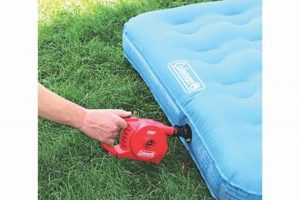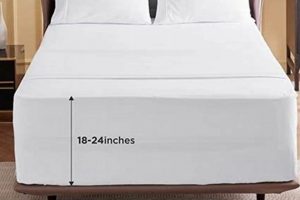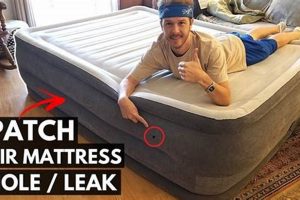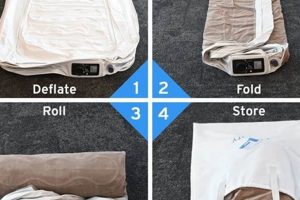Repairing punctures in inflatable sleeping surfaces restores functionality and extends the life of the item. This process generally involves locating the breach, preparing the surrounding area, applying an adhesive and a patch, and allowing sufficient time for bonding. Successful execution prevents air leakage and maintains the structural integrity required for comfortable and supportive use.
Addressing damage promptly offers several advantages, including avoiding the cost of replacement and reducing waste. Furthermore, properly maintained equipment ensures reliable performance when needed, particularly in situations such as camping or accommodating guests. The ability to mend these items aligns with principles of resourcefulness and sustainable practices.
The subsequent sections will outline the necessary materials, detailed step-by-step instructions, and essential precautions for effectively sealing damage and ensuring a lasting repair. The goal is to provide a practical guide to restoring the functionality of inflatable sleeping surfaces.
Effective Strategies for Air Mattress Repair
Implementing these methods enhances the likelihood of a durable and airtight seal following damage.
Tip 1: Accurate Hole Detection: Submerge the inflated surface in water or apply a soapy solution to identify the precise location of the leak through bubble formation. Mark the area clearly for subsequent treatment.
Tip 2: Surface Preparation is Key: Thoroughly clean and degrease the area surrounding the puncture with isopropyl alcohol. This ensures optimal adhesion between the patch and the mattress material.
Tip 3: Appropriate Patch Selection: Employ a patch specifically designed for vinyl or PVC materials, matching the construction of the inflatable surface. Consider using a patch that is larger than the damaged area to provide ample coverage.
Tip 4: Adhesive Application Technique: Apply a thin, even layer of adhesive to both the patch and the prepared surface. Allow the adhesive to become tacky before joining the two surfaces, as per the adhesive manufacturer’s instructions.
Tip 5: Pressure Application for Bonding: After applying the patch, exert firm, consistent pressure on the repaired area for a recommended duration, typically several minutes. This promotes a strong, lasting bond.
Tip 6: Extended Curing Time: Allow the adhesive to fully cure for the recommended time, often 24 hours, before inflating the mattress. Premature inflation may compromise the bond and lead to leakage.
Tip 7: Reinforcement for Large Tears: For sizable tears, consider using multiple overlapping patches or a specialized fabric reinforcement to enhance structural integrity and prevent future failure.
Adhering to these practices optimizes the chances of a successful and long-lasting repair, thereby extending the usable life of the inflatable surface.
The following section offers additional insights into maintaining the repaired air mattress and preventing future damage.
1. Surface Cleanliness
Surface cleanliness is paramount to the successful execution of air mattress repair. Contaminants present on the inflatable material impede adhesive bonding, leading to premature patch failure and air leakage. Rigorous cleaning protocols are therefore essential for ensuring a durable and airtight seal.
- Removal of Particulate Matter
Dust, dirt, and other particulate matter create a physical barrier between the adhesive and the air mattress surface. This prevents the adhesive from forming a strong bond. Effective removal necessitates wiping the area with a clean, lint-free cloth, potentially followed by gentle abrasion with fine-grit sandpaper to create a textured surface for enhanced adhesion.
- Degreasing the Area
Oils, grease, and skin residues compromise adhesive bonding by interfering with the chemical interaction between the adhesive and the air mattress material. Degreasing typically involves using a solvent, such as isopropyl alcohol, to dissolve and remove these contaminants. Proper ventilation during this process is crucial to prevent inhalation of solvent vapors.
- Enhancing Surface Energy
Certain materials exhibit low surface energy, hindering adhesive wetting and spreading. Treating the surface with a primer or adhesion promoter increases surface energy, facilitating better adhesive contact and bond strength. The specific primer must be compatible with both the air mattress material and the adhesive being used.
- Drying and Preparation Time
Residual moisture on the surface can weaken the adhesive bond and promote microbial growth, leading to degradation of the patch and the air mattress material. Allowing sufficient drying time after cleaning or degreasing is therefore critical. Furthermore, roughening the surface slightly with fine-grit sandpaper can increase the surface area available for bonding, enhancing adhesive grip.
Achieving optimal surface cleanliness is a prerequisite for effective repair. Adhering to meticulous cleaning and preparation procedures ensures the creation of a strong, lasting bond, extending the life of the air mattress and preventing recurring leakage.
2. Adhesive Type
The selection of an appropriate adhesive directly influences the success of any repair attempt. Incompatible adhesives fail to create a durable bond with the air mattress material, leading to air leakage and the necessity for repeated repairs. The primary air mattress material, typically PVC (polyvinyl chloride) or a similar polymer, dictates the required adhesive properties. An adhesive intended for porous materials, for instance, will not effectively bond with the smooth, non-porous surface of a PVC air mattress. Consequently, a PVC-specific adhesive formulated to chemically interact with the mattress material is crucial.
The practical significance of understanding adhesive properties extends to scenarios involving varying degrees of damage. Small punctures may be addressed with a simple vinyl repair kit containing a pre-packaged adhesive. However, larger tears or areas subjected to significant stress require more specialized adhesives exhibiting greater tensile strength and flexibility. Cyanoacrylate adhesives (“super glue”) are generally unsuitable due to their brittleness and tendency to crack under pressure, whereas flexible PVC cements offer a more resilient and airtight seal. Real-world examples of patch failures often stem from the use of inappropriate adhesive types, demonstrating the critical link between adhesive selection and repair longevity.
In conclusion, the choice of adhesive represents a pivotal decision in the repair process. Matching the adhesive’s chemical properties to the air mattr
ess material ensures a robust, airtight bond. While readily available repair kits can address minor damage, more substantial repairs demand adhesives with enhanced strength and flexibility. Understanding the specific material composition of the air mattress and selecting a compatible adhesive is therefore essential for achieving a successful and long-lasting patch.
3. Patch Material
The efficacy of any method depends significantly on the materials employed, particularly the patching component. Selecting an appropriate patching material directly impacts the longevity and reliability of the repair.
- Material Compatibility
The patch material must exhibit compatibility with the inflatable surface’s composition, typically PVC or a similar polymer. A mismatch in material properties compromises adhesion and leads to premature failure. For instance, a fabric patch adhered to a PVC surface without a suitable bonding agent will likely detach upon inflation. Real-world repair failures underscore the importance of using materials that chemically bond or mechanically interlock with the air mattress surface.
- Tensile Strength and Flexibility
Patches must possess adequate tensile strength to withstand the internal pressure of the inflated mattress without tearing or stretching. Concurrently, flexibility is crucial to accommodate the mattress’s contours and movements without compromising the bond. Rigid patches applied to flexible surfaces create stress points that can lead to new punctures. Consider patching a heavily used area versus an infrequently touched area.
- Adhesive Properties
The patch material’s surface characteristics must readily accept and retain adhesive. Smooth, non-porous surfaces may require surface preparation, such as light abrasion, to enhance adhesion. Conversely, some patch materials come pre-treated with an adhesive layer, simplifying the repair process. However, the quality and compatibility of the pre-applied adhesive must be carefully evaluated.
- Durability and Environmental Resistance
Patches should exhibit resistance to degradation from environmental factors such as UV radiation, temperature fluctuations, and moisture. Exposure to these elements can weaken the patch material and the adhesive bond over time. Patches designed for outdoor use typically incorporate UV inhibitors and waterproof coatings to enhance durability. The lifespan of a repaired air mattress is directly proportional to the environmental resistance of the patch.
In summary, successful puncture repair necessitates a careful evaluation of the physical and chemical properties of the patch material. Compatibility, strength, flexibility, and environmental resistance all contribute to a durable and reliable seal, extending the functional life of the inflatable surface.
4. Application Pressure
Adequate application pressure constitutes a critical element in securing a successful patch. The process relies on establishing an intimate contact between the patch, the adhesive, and the inflatable surface. Insufficient pressure results in incomplete bonding, leaving voids or air pockets that compromise the seal’s integrity. Consequently, air leakage occurs, rendering the repair ineffective. The pressure exerted during patch application forces the adhesive to spread uniformly across the surfaces, maximizing the contact area and facilitating a strong, cohesive bond. Without this applied force, the adhesive may only adhere to the peaks of the surface texture, leaving the valleys unbonded and prone to leakage.
Consider the scenario of repairing a puncture on an air mattress used for camping. If the patch is simply placed over the punctured area without applying sustained pressure, the adhesive may not fully penetrate the textured surface of the mattress. The vibrations and movement experienced during use would then quickly dislodge the patch, leading to deflation. Conversely, applying firm, even pressure for the duration recommended by the adhesive manufacturer ensures that the adhesive conforms to the surface irregularities, creating a secure and durable seal. Clamping mechanisms or heavy weights can effectively provide this sustained pressure, particularly for larger repairs or when dealing with thicker materials. This methodology ensures consistent contact across the entire patched area, maximizing adhesive effectiveness.
In conclusion, the connection between effective patch application and exerted pressure cannot be overstated. Consistent and adequate pressure promotes optimal adhesive contact, maximizing the strength and longevity of the repair. Disregard for this crucial step often leads to premature patch failure and recurring air leakage. Therefore, dedicating sufficient time and resources to applying appropriate pressure during patch application directly contributes to a successful, long-lasting repair of an air mattress, extending its usable lifespan and preventing unnecessary waste.
5. Curing Time
Curing time represents a critical phase in the repair process, directly impacting the integrity and longevity of the bond established between the patch and the air mattress material. Insufficient curing compromises the adhesive’s ability to achieve its full strength, rendering the repair vulnerable to leakage and premature failure.
- Adhesive Polymerization
Curing time facilitates the complete polymerization of the adhesive. Polymerization involves the cross-linking of adhesive molecules, forming a robust and durable matrix. Premature use before complete polymerization results in a weak and flexible bond, susceptible to deformation and detachment under stress. Adherence to the manufacturer-specified curing duration is, therefore, paramount.
- Solvent Evaporation
Many adhesives contain solvents that maintain fluidity during application. Curing time allows for the complete evaporation of these solvents. Trapped solvents can weaken the adhesive bond, cause blistering, or chemically react with the air mattress material. Incomplete solvent evaporation is a common cause of patch failure, particularly in humid environments.
- Bond Strength Development
Adhesive bond strength increases exponentially during the curing period. Initial adhesion may be sufficient to hold the patch in place, but full bond strength develops only after complete curing. Stressing the repaired area before full bond strength is achieved can permanently weaken the bond, leading to eventual failure. The relationship between curing time and bond strength is non-linear; the final stages of curing often contribute disproportionately to overall strength.
- Environmental Considerations
Ambient temperature and humidity levels significantly influence curing time. Lower temperatures slow down the polymerization process, while high humidity can impede solvent evaporation. In adverse environmental conditions, extending the curing time beyond the manufacturer’s recommendations may be necessary to ensure a robust and lasting bond. Monitoring and adjusting curing time based on environmental factors is a best practice.
li>
In summation, proper curing time is indispensable for achieving a successful and durable air mattress repair. By allowing sufficient time for adhesive polymerization, solvent evaporation, and bond strength development, individuals can significantly extend the lifespan of their air mattresses and prevent recurring leakage. Adherence to manufacturer guidelines, coupled with consideration of environmental factors, maximizes the effectiveness of the repair.
6. Leak detection
Effective repair of an air mattress is contingent upon accurate and comprehensive breach localization. The relationship between discovering the source of egress and the subsequent sealing action is causal; without proper identification of the escape point, any remedial effort is inherently futile. Air mattresses, especially those subjected to frequent use or storage, are susceptible to punctures from various sources, often resulting in slow leaks that are difficult to pinpoint through visual inspection alone. The presence of a slow leak necessitates employing active detection methods to guarantee a lasting and complete repair. For example, blindly applying patches to suspected areas without confirmation of the actual leak location invariably leads to continued air loss and a wasted investment of time and materials.
Active leak detection commonly involves the application of a soapy water solution to the inflated surface of the mattress. The formation of bubbles at a specific location indicates the presence of a puncture. Submerging sections of the mattress in water can also reveal the leak point through the visual observation of escaping air bubbles. Once a leak has been identified, its precise location must be marked for subsequent cleaning and patch application. Ignoring this critical step risks misapplication of the patch, potentially covering a section of the mattress adjacent to the actual puncture and thus failing to resolve the air loss problem. Furthermore, thorough detection ensures that all leaks are addressed, preventing the occurrence of multiple slow leaks that cumulatively contribute to rapid deflation.
In conclusion, effective leak detection is not merely a preliminary step, but an indispensable component of a successful puncture repair. Employing active detection methods, precisely marking leak locations, and ensuring comprehensive coverage of all breaches is essential for achieving a durable and airtight seal. Overlooking this aspect invariably results in continued air loss and the need for repeated repair attempts. The meticulous application of leak detection principles directly correlates with the long-term functionality and usability of the repaired air mattress.
7. Long-term prevention
Prolonging the functional lifespan of an air mattress necessitates a proactive approach beyond mere repair. While proficiency in patching punctures is valuable, preventing damage in the first instance minimizes the frequency and scope of such interventions, reducing both expenditure and inconvenience.
- Protective Barriers
Employing a fitted mattress cover or topper serves as a physical shield against abrasion, puncture, and staining. These barriers absorb friction from movement and prevent contact with sharp objects, thereby reducing the likelihood of damage. For instance, using a thick mattress pad can prevent tears caused by bed frames or accidental contact with small objects during use. The protective barrier is replaced, not the whole air mattress.
- Appropriate Usage Environments
Limiting the use of air mattresses to clean, debris-free environments minimizes the risk of puncture. Avoid placing air mattresses on rough surfaces such as gravel, concrete, or uncarpeted floors. When used outdoors, ensure that the ground is thoroughly cleared of sharp objects and utilize a groundsheet or tarp for added protection. This reduces the likelihood of an avoidable puncture.
- Proper Inflation Practices
Overinflation places undue stress on the mattress seams and material, increasing the risk of bursting or developing leaks. Adhering to the manufacturer’s recommended inflation levels prevents overextension and prolongs the mattress’s structural integrity. Conversely, underinflation can cause excessive flexing, leading to material fatigue and potential tears. A balanced inflation level is crucial.
- Strategic Storage Techniques
Proper storage minimizes the risk of damage during periods of non-use. Deflating the mattress completely, folding it neatly, and storing it in a cool, dry place away from direct sunlight prevents material degradation and potential punctures. Storing the mattress in a protective bag further safeguards it from dust, pests, and accidental damage. Correct storage avoids many repair scenarios.
Integrating these preventive measures reduces the reliance on patching punctures. By prioritizing protection, appropriate usage, and proper storage, the frequency and necessity of repair interventions are significantly diminished, extending the air mattress’s functional life and optimizing its long-term value. Proactive steps yield the best results for air mattress maintenance.
Frequently Asked Questions
This section addresses common inquiries and clarifies prevalent misconceptions related to mending breaches in inflatable mattresses, offering guidance on achieving effective and lasting repairs.
Question 1: Can any adhesive be used to patch inflatable mattresses?
No, not all adhesives are suitable. The inflatable mattress material is typically PVC or a similar polymer, requiring an adhesive specifically formulated for bonding with these materials. Incompatible adhesives will result in a weak, short-lived seal.
Question 2: Is surface preparation truly necessary, or can the patch be applied directly?
Surface preparation is a crucial step. Contaminants such as dirt, oil, and debris will impede adhesive bonding. Cleaning the area with isopropyl alcohol ensures optimal adhesion, leading to a stronger and more durable repair.
Question 3: How long should the adhesive cure before inflating the mattress?
Adhesive manufacturers typically specify a curing time, often 24 hours. Adhering to this recommended duration allows the adhesive to fully polymerize, achieving its maximum bond strength. Premature inflation may compromise the repair.
Question 4: What is the best method for locating small, slow leaks?
Submerging the inflated mattress in water or applying a soapy water solution to the surface are effective methods for identifying leaks. The formation of bubbles at a specific location indicates the presence of a puncture.
Question 5: Can large tears be effectively repaired, or is replacement necessary?
Large tears can be repaired, but they require specialized techniques and materials. Multiple overlapping patches or the use of a fabric reinforcement may be necessary to ensure structural integrity. The extent of the damage will dictate whether repair is feasible or replacement is more practical.
Question 6: Are commercially available repair kits sufficient for most punctures?
Commercially available repair kits are generally adequate for small punctures. However, their
effectiveness depends on the quality of the included adhesive and patch material. Larger tears or areas subject to high stress may require more specialized repair solutions.
Effective puncture repair extends the lifespan of inflatable surfaces and mitigates unnecessary replacement costs. Proper technique, compatible materials, and patience are essential for achieving a successful and lasting result.
This concludes the exploration of common inquiries related to inflatable mattress repair. The subsequent section delves into advanced techniques for addressing specific types of damage.
How to Patch a Hole in an Air Mattress
The foregoing exploration has elucidated essential principles for effectively patching punctures in inflatable sleeping surfaces. Accurate leak detection, meticulous surface preparation, the selection of compatible materials, appropriate application pressure, and sufficient curing time are critical determinants of a successful and enduring repair. Adherence to these best practices maximizes the probability of restoring the air mattress to its intended functionality.
Mastering the art of patching punctures not only presents a cost-effective alternative to replacement but also promotes responsible consumption and waste reduction. Continued refinement of techniques, coupled with proactive preventative measures, will further enhance the lifespan and utility of inflatable sleeping surfaces, ensuring reliable performance and minimizing environmental impact. This empowers individuals to extend product lifecycles and minimizes reliance on disposable consumerism.


